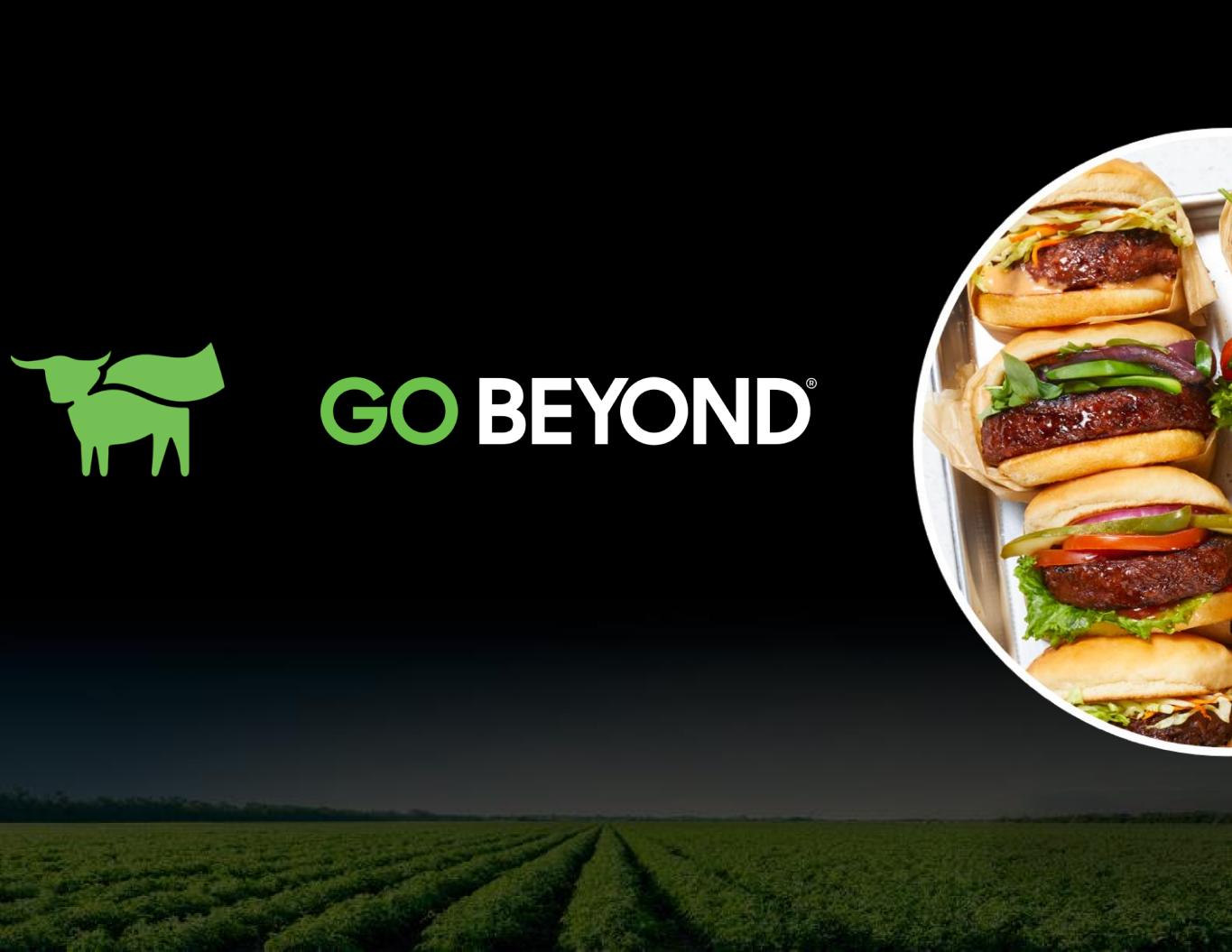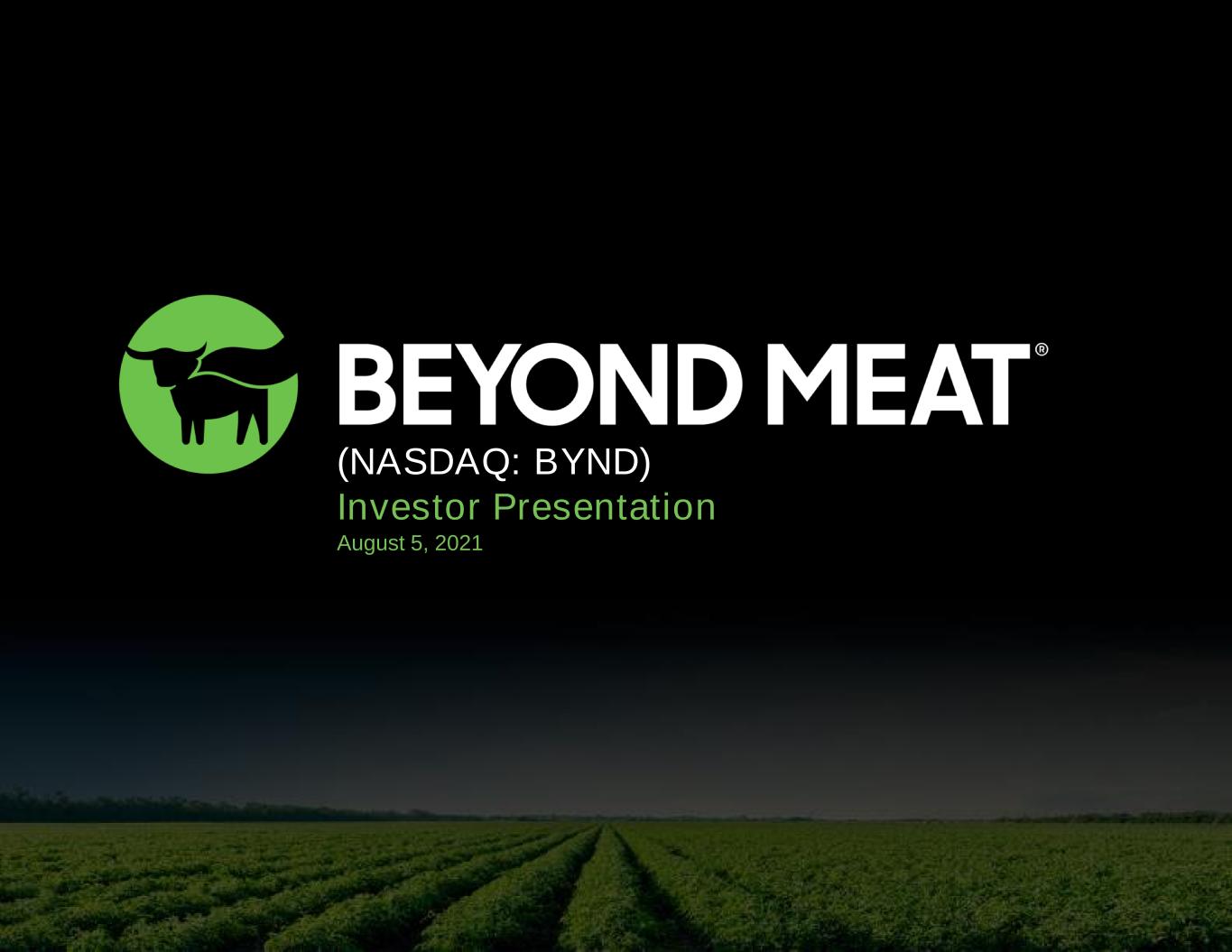
Investor Presentation (NASDAQ: BYND) August 5, 2021

This presentation contains, in addition to historical information, certain forward-looking statements that are based on our current assumptions, expectations and projections about future performance and events and relate to, among other matters, our future financial performance, our business strategy, industry and market trends, future expectations concerning our market position, future operations and capital expenditures. Forward-looking statements generally contain words such as "believes," "expects," "may," "will," "should," "seeks," "approximately," "intends," "plans," "estimates," "anticipates," and similar expressions. These forward-looking statements are only predictions, not historical fact. You should, therefore, not rely on these forward-looking statements as representing our views as of any date subsequent to the date of this presentation. Forward-looking statements are based on information available at the time those statements are made and/or management’s good faith belief as of that time with respect to future events and are subject to risks and uncertainties that could cause actual performance or results to differ materially from those expressed in or suggested by the forward- looking statements. Important factors that could cause actual results to differ materially from expectations include, among others: the duration, magnitude and effect of the COVID-19 pandemic including on our supply chain, the demand for our products, our product and channel mix, the timing and level of retail purchasing, our manufacturing facilities and operations, our inventory levels, our ability to expand and produce in new geographic markets or the timing of such expansion efforts, the pace and success of new product introductions, the timing of new foodservice launches, and on overall economic conditions and consumer confidence and spending levels; estimates of our expenses, future revenues, capital expenditures, capital requirements and our needs for additional financing; our ability to identify and execute cost-down initiatives intended to achieve price parity with animal protein; the effects of increased competition from our market competitors and new market entrants; our ability to effectively manage our growth; the failure of acquisitions and other investments to be efficiently integrated and produce the results we anticipate; the success of operations conducted by joint ventures; the timing and success of distribution expansion and new product introductions in increasing revenues and market share; the timing and success of strategic partnership launches and limited time offerings resulting in permanent menu items; the timing and level of trade and promotion discounts; our ability to effectively manage and expand our manufacturing and production capacity, forecast demand and manage our inventory; our ability to successfully enter new markets, manage our international expansion and comply with any applicable laws and regulations; the success of our marketing efforts and the ability to grow brand awareness, maintain, protect and enhance our brand, attract and retain new customers and grow our market share; changes in consumer tastes and trends; changes in government regulations and policies; legislation or changes in laws affecting plant-based meat, the labeling or naming of our products, or our brand name or logo; availability and prices of raw materials for our products; the impact of inflation across the economy; outcomes of legal or administrative proceedings; the financial condition of, and our relationship with our suppliers, co-manufacturers, distributors, retailers and foodservice customers; the ability of our suppliers and co-manufacturers to comply with food safety, environmental or other laws or regulations; the effectiveness of internal controls; and general economic conditions. We are under no duty to update any of these forward-looking statements after the date of this presentation except as otherwise required by law. Our historical results are not necessarily indicative of the results to be expected for any future periods and our operating results for the three and six months ended July 3, 2021 are not necessarily indicative of the results that may be expected for any other interim periods or any future year or period. This presentation also contains estimates and other statistical data obtained from independent parties and by us relating to market size and growth and other data about our industry and ultimate consumers. The number of retail and foodservice outlets are derived from data through June 2021. This data involves a number of assumptions and limitations, and you are cautioned not to give undue weight to such estimates and data. In addition, projections, assumptions and estimates of our future performance and the future performance of the geographic and other markets in which we operate are necessarily subject to a high degree of uncertainty and risk. “Beyond Meat,” “Beyond Burger,” “Beyond Sausage,” “Beyond Breakfast Sausage,” “Beyond Breakfast Sausage Links,” “Beyond Breakfast Sausage Patties,” “Beyond Meatballs,” “Beyond Chicken Tenders,” the Caped Steer Logo and “The Future of Protein” are registered trademarks of Beyond Meat, Inc. in the United States and, in some cases, in certain other countries. All other brand names or trademarks appearing in this presentation are the property of their respective holders. Solely for convenience, the trademarks and trade names in this presentation are referred to without the ® and ™ symbols, but such references should not be construed as any indicator that their respective owners will not assert, to the fullest extent under applicable law, their rights thereto. Disclaimer 2
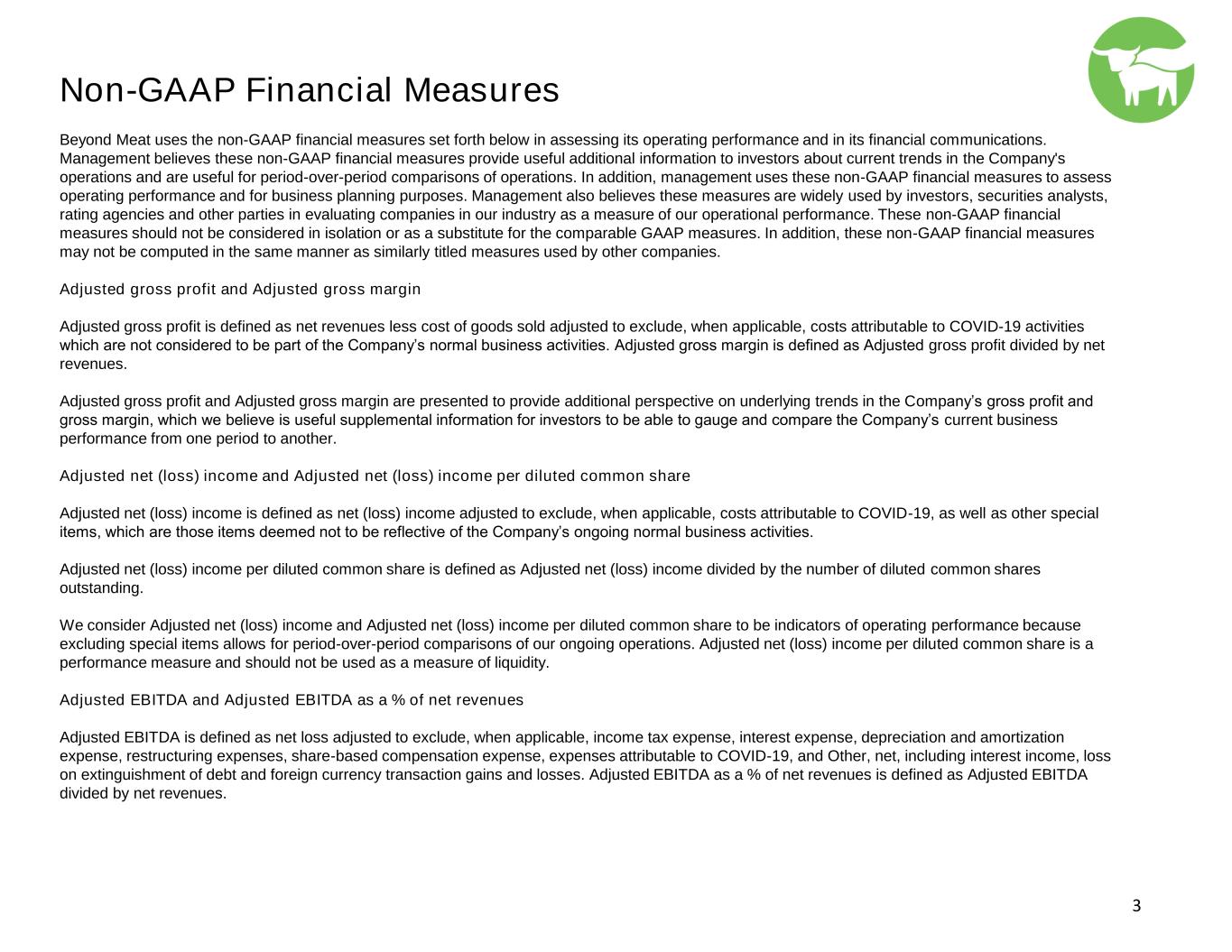
Beyond Meat uses the non-GAAP financial measures set forth below in assessing its operating performance and in its financial communications. Management believes these non-GAAP financial measures provide useful additional information to investors about current trends in the Company's operations and are useful for period-over-period comparisons of operations. In addition, management uses these non-GAAP financial measures to assess operating performance and for business planning purposes. Management also believes these measures are widely used by investors, securities analysts, rating agencies and other parties in evaluating companies in our industry as a measure of our operational performance. These non-GAAP financial measures should not be considered in isolation or as a substitute for the comparable GAAP measures. In addition, these non-GAAP financial measures may not be computed in the same manner as similarly titled measures used by other companies. Adjusted gross profit and Adjusted gross margin Adjusted gross profit is defined as net revenues less cost of goods sold adjusted to exclude, when applicable, costs attributable to COVID-19 activities which are not considered to be part of the Company’s normal business activities. Adjusted gross margin is defined as Adjusted gross profit divided by net revenues. Adjusted gross profit and Adjusted gross margin are presented to provide additional perspective on underlying trends in the Company’s gross profit and gross margin, which we believe is useful supplemental information for investors to be able to gauge and compare the Company’s current business performance from one period to another. Adjusted net (loss) income and Adjusted net (loss) income per diluted common share Adjusted net (loss) income is defined as net (loss) income adjusted to exclude, when applicable, costs attributable to COVID-19, as well as other special items, which are those items deemed not to be reflective of the Company’s ongoing normal business activities. Adjusted net (loss) income per diluted common share is defined as Adjusted net (loss) income divided by the number of diluted common shares outstanding. We consider Adjusted net (loss) income and Adjusted net (loss) income per diluted common share to be indicators of operating performance because excluding special items allows for period-over-period comparisons of our ongoing operations. Adjusted net (loss) income per diluted common share is a performance measure and should not be used as a measure of liquidity. Adjusted EBITDA and Adjusted EBITDA as a % of net revenues Adjusted EBITDA is defined as net loss adjusted to exclude, when applicable, income tax expense, interest expense, depreciation and amortization expense, restructuring expenses, share-based compensation expense, expenses attributable to COVID-19, and Other, net, including interest income, loss on extinguishment of debt and foreign currency transaction gains and losses. Adjusted EBITDA as a % of net revenues is defined as Adjusted EBITDA divided by net revenues. 3 Non-GAAP Financial Measures
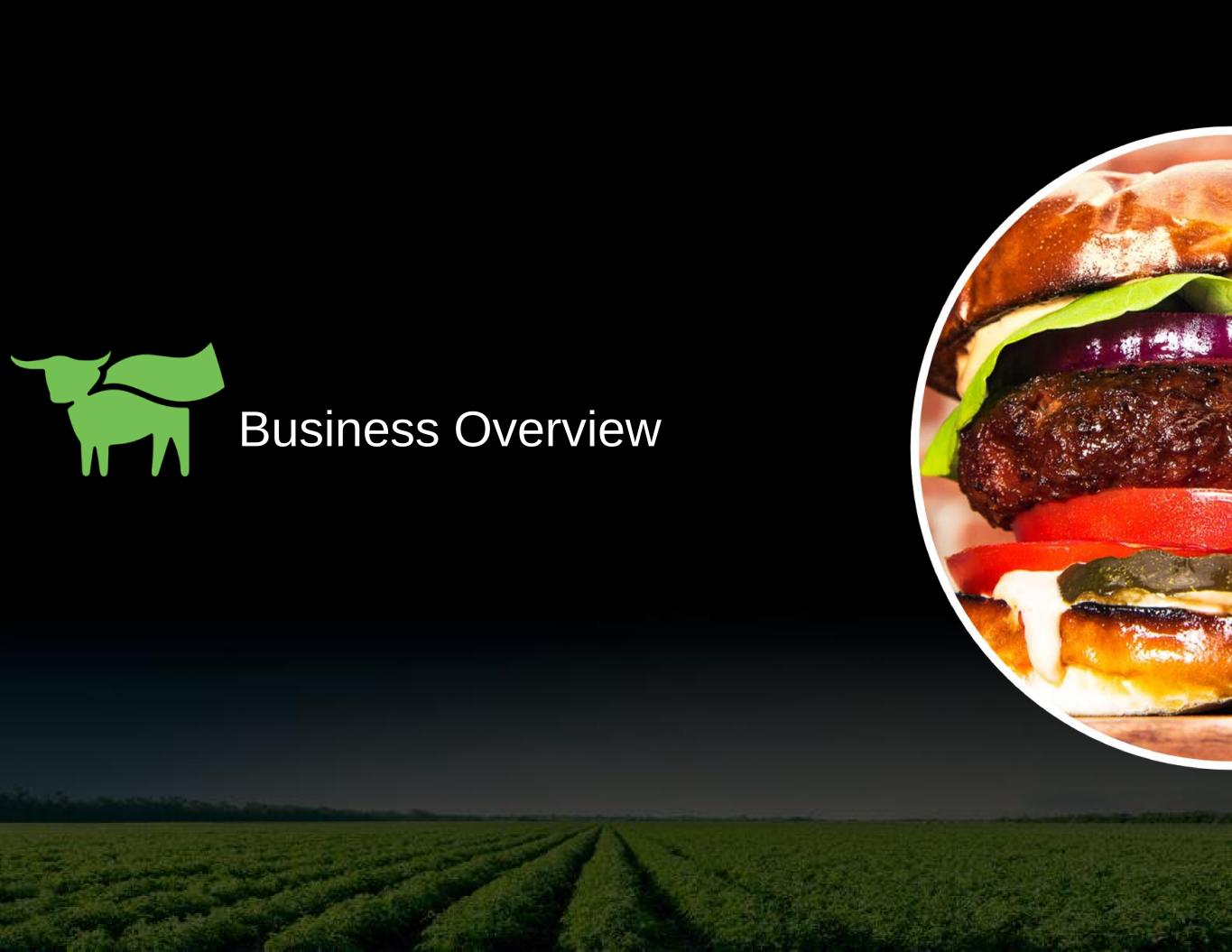
Business Overview

We Use Proprietary Science to Redefine Meat Beyond Meat’s Proprietary Technology & Process are Used to Replicate Animal Meat’s Principal Components from Plant Proteins 5 We begin with meat’s COMPOSITION versus its animal ORIGIN Then replicate its core structure & sensory experience Microscopy Comparing Beyond Sausage to Pork Sausage Actual Images of the Beyond Burger and Ground Beef Scanning Electronic Microscopy Confocal Laser Microscopy Beyond Sausage Pork Sausage Raw Cooked Beyond Burger Ground Beef

29% Of the water in agriculture is directly or indirectly used for animal production 3 78% Of all agricultural land is used for livestock, including grazing land and cropland dedicated to the production of feed4 30% Of most cancers in developed countries attributed to dietary factors, including consumption of certain meats2 We are Committed to Providing Products that Enable Consumers to Eat What You LoveTM 6 42% Reduced risk of developing heart failure associated with people who eat a mostly plant-based diet1 18-51% Of global greenhouse gas emissions driven by livestock rearing and processing3 60 - 70 Billion Farm animals reared for food each year5 With current food production systems threatening both human health and environmental sustainability, plant-based diets offer a growing global population a solution of healthy diets and sustainable food systems6 1 Plant Based Diet Associated with Less Heart Failure Risk Report, presented at the American Heart Association scientific meeting, November 13, 2017. 2 Key, Timothy J. et al., Diet, nutrition and the prevention of cancer, Scientific background papers of the joint WHO/FAO expert consultation, Geneva, 28 January - 1 February 2002, Public Health Nutrition, Vol 7, No. 1(A), Supplement 1001, February 2004. 3 Reprinted from Water Resources and Industry, Volumes 1–2, March–June 2013, P.W. Gerbens-Leenes, M.M. Mekonnen, A.Y. Hoekstra, The water footprint of poultry, pork and beef: A comparative study in different countries and production systems, Page No. 26, Copyright (2013), with permission from Elsevier. 4 Livestock’s Long Shadow-Environmental Issues and Options, Food and Agriculture Organization of the United Nations, 2006. 5 Compassion in World Farming, Strategic Plan 2013-2017. 6 Food in the Anthropocene: the EAT–Lancet Commission on healthy diets from sustainable food systems, 2019.
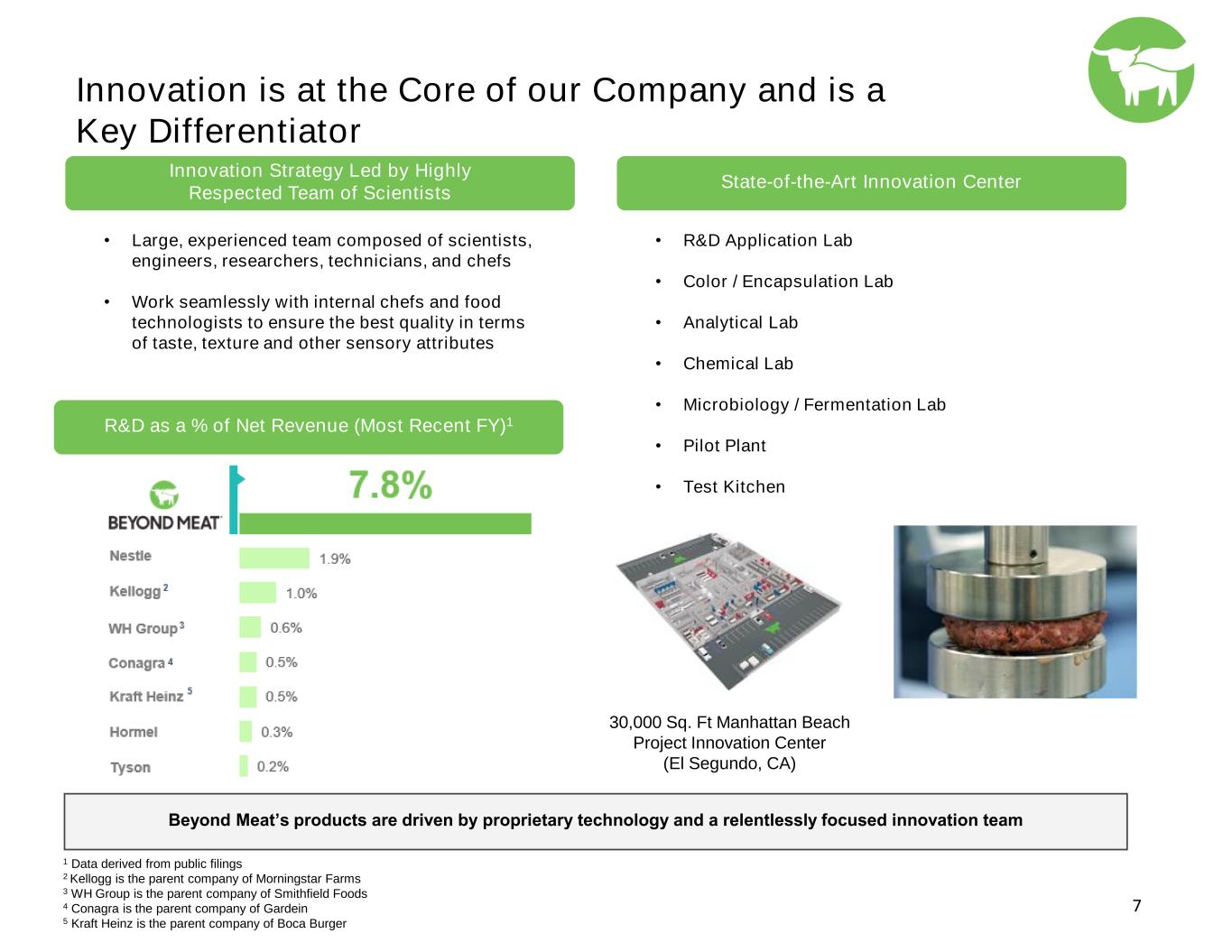
Innovation is at the Core of our Company and is a Key Differentiator 7 Innovation Strategy Led by Highly Respected Team of Scientists State-of-the-Art Innovation Center • Large, experienced team composed of scientists, engineers, researchers, technicians, and chefs • Work seamlessly with internal chefs and food technologists to ensure the best quality in terms of taste, texture and other sensory attributes • R&D Application Lab • Color / Encapsulation Lab • Analytical Lab • Chemical Lab • Microbiology / Fermentation Lab • Pilot Plant • Test Kitchen 30,000 Sq. Ft Manhattan Beach Project Innovation Center (El Segundo, CA) R&D as a % of Net Revenue (Most Recent FY)1 Beyond Meat’s products are driven by proprietary technology and a relentlessly focused innovation team 1 Data derived from public filings 2 Kellogg is the parent company of Morningstar Farms 3 WH Group is the parent company of Smithfield Foods 4 Conagra is the parent company of Gardein 5 Kraft Heinz is the parent company of Boca Burger
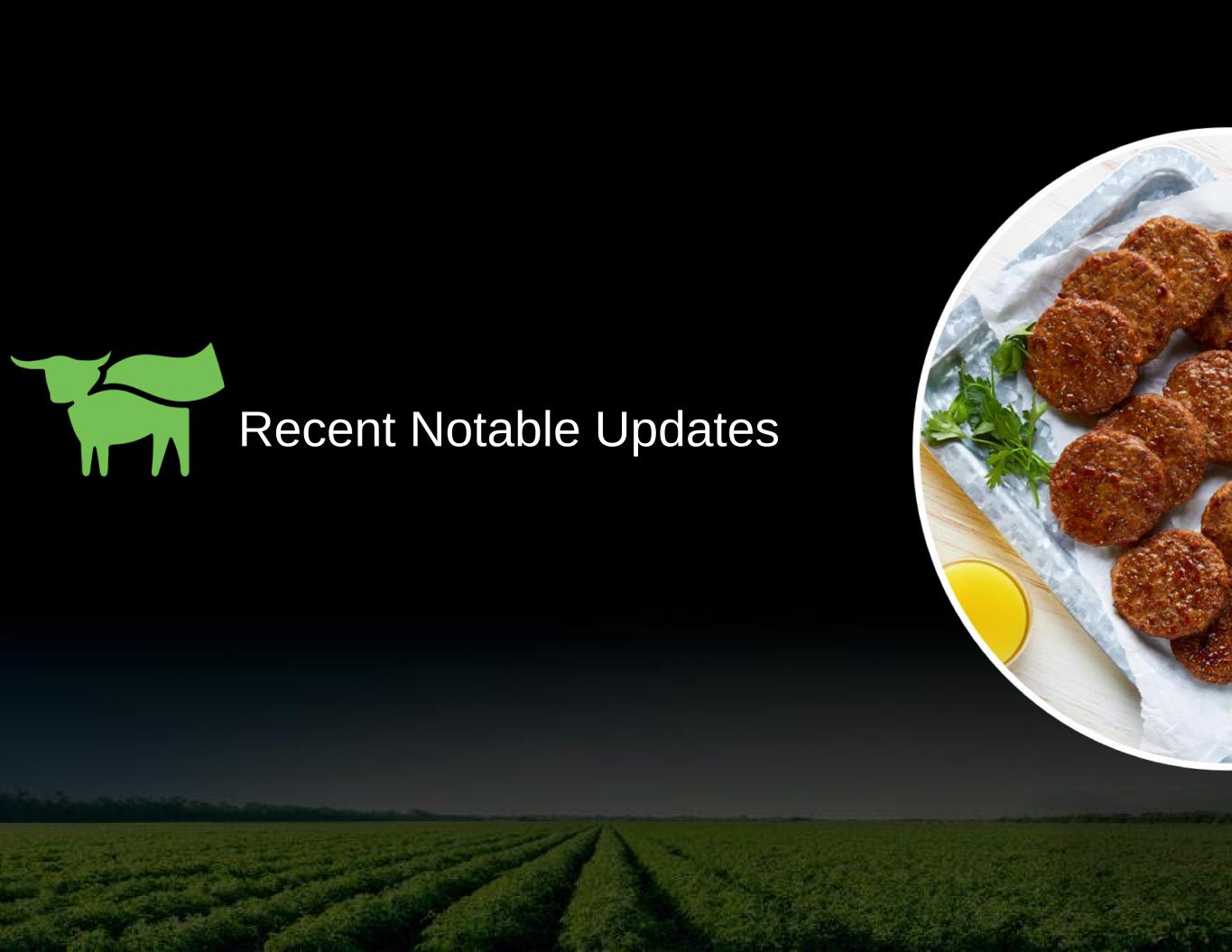
Recent Notable Updates
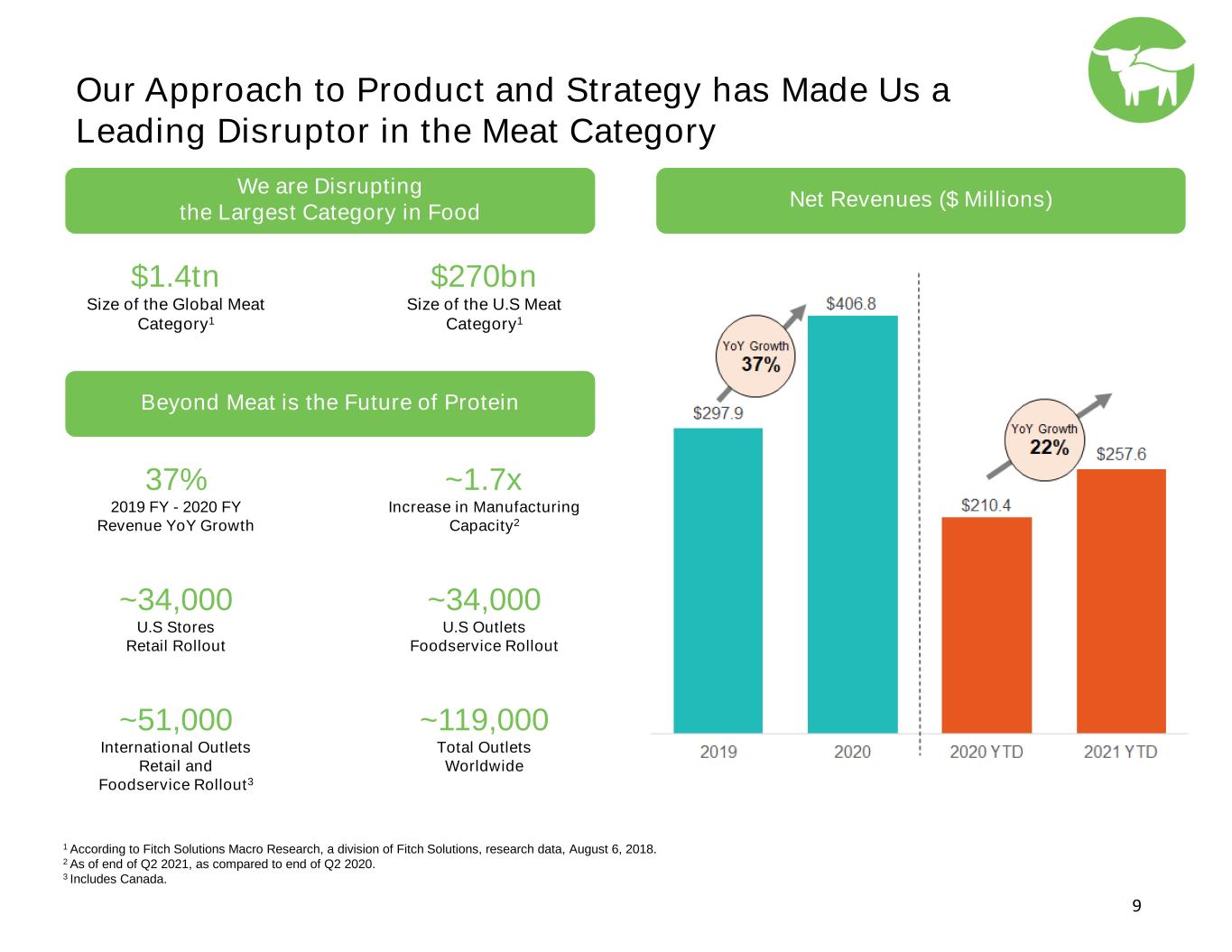
$1.4tn Size of the Global Meat Category1 Our Approach to Product and Strategy has Made Us a Leading Disruptor in the Meat Category 9 We are Disrupting the Largest Category in Food 1 According to Fitch Solutions Macro Research, a division of Fitch Solutions, research data, August 6, 2018. 2 As of end of Q2 2021, as compared to end of Q2 2020. 3 Includes Canada. Net Revenues ($ Millions) $270bn Size of the U.S Meat Category1 Beyond Meat is the Future of Protein 37% 2019 FY - 2020 FY Revenue YoY Growth ~1.7x Increase in Manufacturing Capacity2 ~34,000 U.S Stores Retail Rollout ~51,000 International Outlets Retail and Foodservice Rollout3 ~34,000 U.S Outlets Foodservice Rollout ~119,000 Total Outlets Worldwide
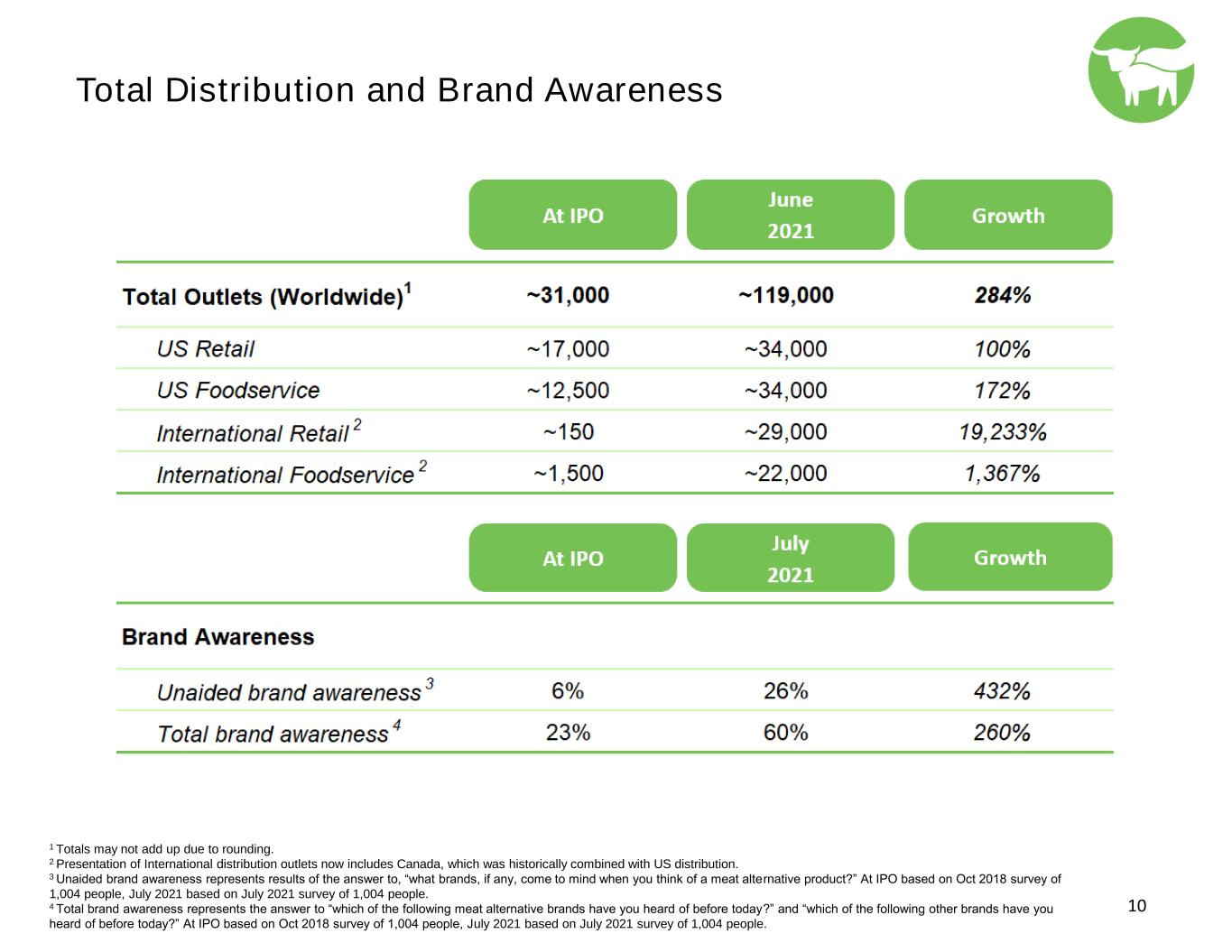
Total Distribution and Brand Awareness 10 1 Totals may not add up due to rounding. 2 Presentation of International distribution outlets now includes Canada, which was historically combined with US distribution. 3 Unaided brand awareness represents results of the answer to, “what brands, if any, come to mind when you think of a meat alternative product?” At IPO based on Oct 2018 survey of 1,004 people, July 2021 based on July 2021 survey of 1,004 people. 4 Total brand awareness represents the answer to “which of the following meat alternative brands have you heard of before today?” and “which of the following other brands have you heard of before today?” At IPO based on Oct 2018 survey of 1,004 people, July 2021 based on July 2021 survey of 1,004 people.

U.S. Retail Velocity and Market Share Trends 11 Source: SPINS Data through June 13, 2021 1 Includes aggregate data for Beyond Meat products across all Frozen and Refrigerated Plant-Based Meats in the US MULO channel only 2 Includes aggregate data for Beyond Meat products across all Frozen and Refrigerated Plant-Based Meats in both the US MULO and US Natural Enhanced channels * Growth in total distribution points (TDP) for the Beyond Meat brand was up 58%, 55% and 55% year-over-year for the 52-week, 12-week and 4-week periods ended June 13, 2021, respectively 1 2

Sales by Distribution Channel 12 U.S Retail Net Revenues ($ Millions) U.S Foodservice International Select Customers Select Highlight Retail points of distribution across the United States carrying Beyond Meat products ~17,000 At IPO ~34,000 June 2021 Net Revenues ($ Millions) Net Revenues ($ Millions) Select Customers Select Highlight Foodservice outlets across the United States carrying Beyond Meat products ~12,500 At IPO Select Customers Select Highlight International Retail and Foodservice outlets carrying Beyond Meat products ~1,650 At IPO ~34,000 June 2021 ~51,000 June 2021

Recent Notable Updates Beyond Meat Rapid & Relentless Innovation Program Is Designed to Make Our Existing Products Obsolete, Generate New Products & Platforms, and Serve A Widening Circle of Customers Customers Products International 13 We continue to expand our foodservice partnerships, with the announcement of new or expanded customer relationships We continue to focus on innovation, including rollouts of both new and enhanced product offerings Multiple new product launches / enhancements over the past 2 years Beyond Breakfast Sausage Links (2020) Beyond Meatballs (2020) Beyond Breakfast Sausage Patties (2020) Beyond Burger 3.0 (2021) International Supply Chain January 2021 Sweden + Denmark Limited Test Beyond Beef 3.0 (2021) Available in more than 80 countries worldwide Other Notable Highlights: • Beyond Chicken Tenders wins 2021 FABI Award (National Restaurant Association) Established 1st extrusion facility outside of the U.S in Enschede, Netherlands (Full commercial production expected in Q3) Opened new state-of-the-art manufacturing facility in Jiaxing, China (Commenced commercial production in April 2021) March 2021 US Permanent Item March 2021 US Permanent Item April 2021 US Permanent Item July 2021 US Limited Test August 2021 Canada Nationwide LTO Beyond Chicken Tenders (2021)
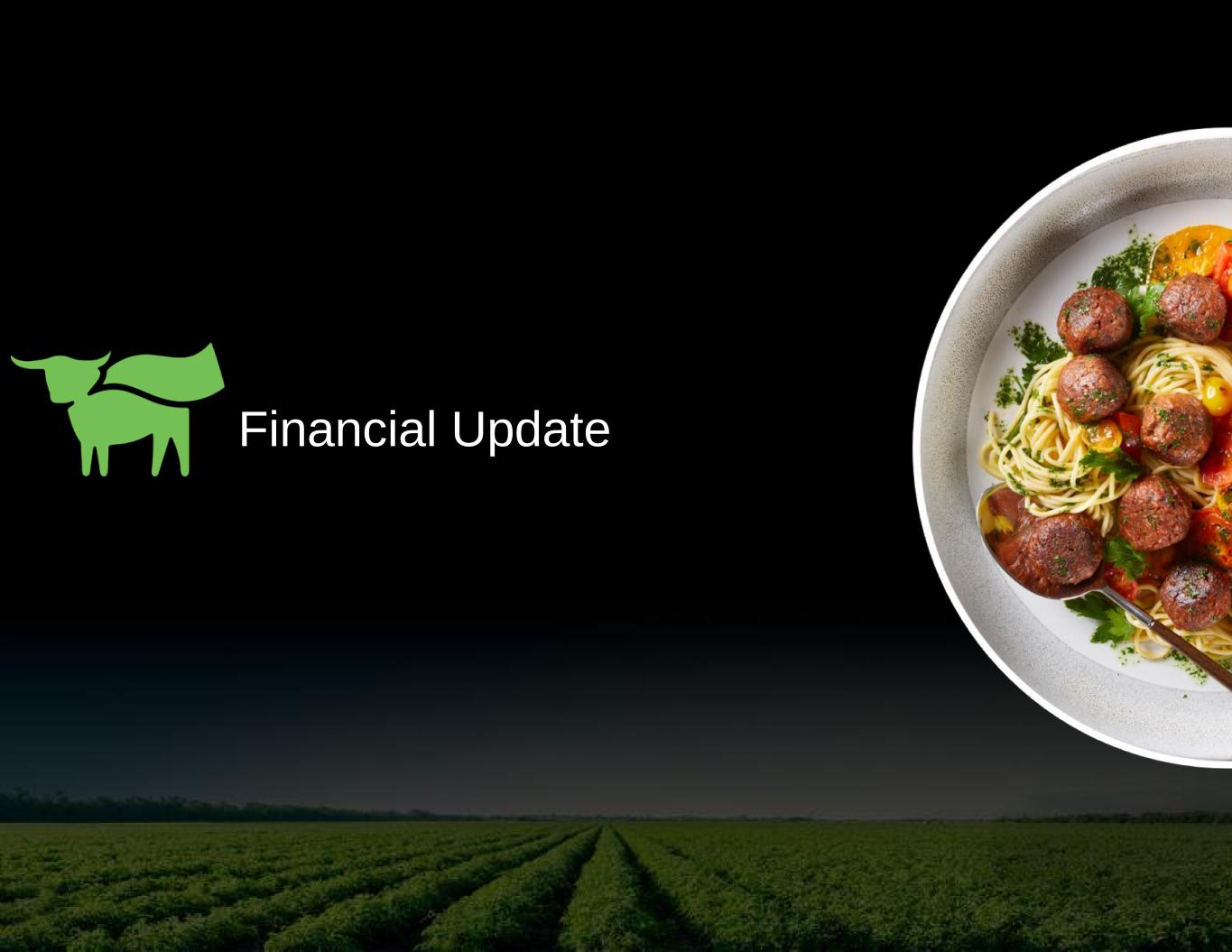
Financial Update
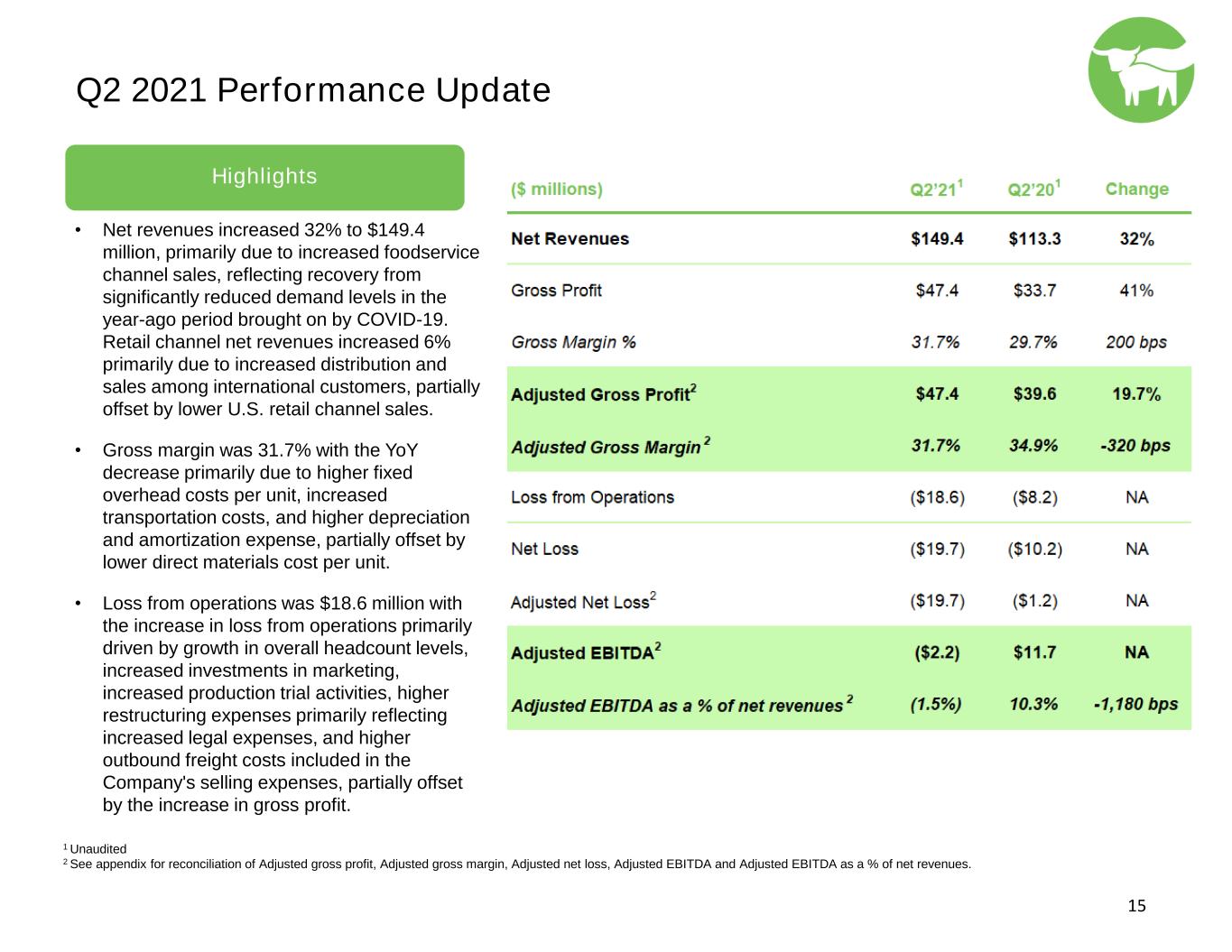
• Net revenues increased 32% to $149.4 million, primarily due to increased foodservice channel sales, reflecting recovery from significantly reduced demand levels in the year-ago period brought on by COVID-19. Retail channel net revenues increased 6% primarily due to increased distribution and sales among international customers, partially offset by lower U.S. retail channel sales. • Gross margin was 31.7% with the YoY decrease primarily due to higher fixed overhead costs per unit, increased transportation costs, and higher depreciation and amortization expense, partially offset by lower direct materials cost per unit. • Loss from operations was $18.6 million with the increase in loss from operations primarily driven by growth in overall headcount levels, increased investments in marketing, increased production trial activities, higher restructuring expenses primarily reflecting increased legal expenses, and higher outbound freight costs included in the Company's selling expenses, partially offset by the increase in gross profit. Q2 2021 Performance Update 15 Highlights 1 Unaudited 2 See appendix for reconciliation of Adjusted gross profit, Adjusted gross margin, Adjusted net loss, Adjusted EBITDA and Adjusted EBITDA as a % of net revenues.
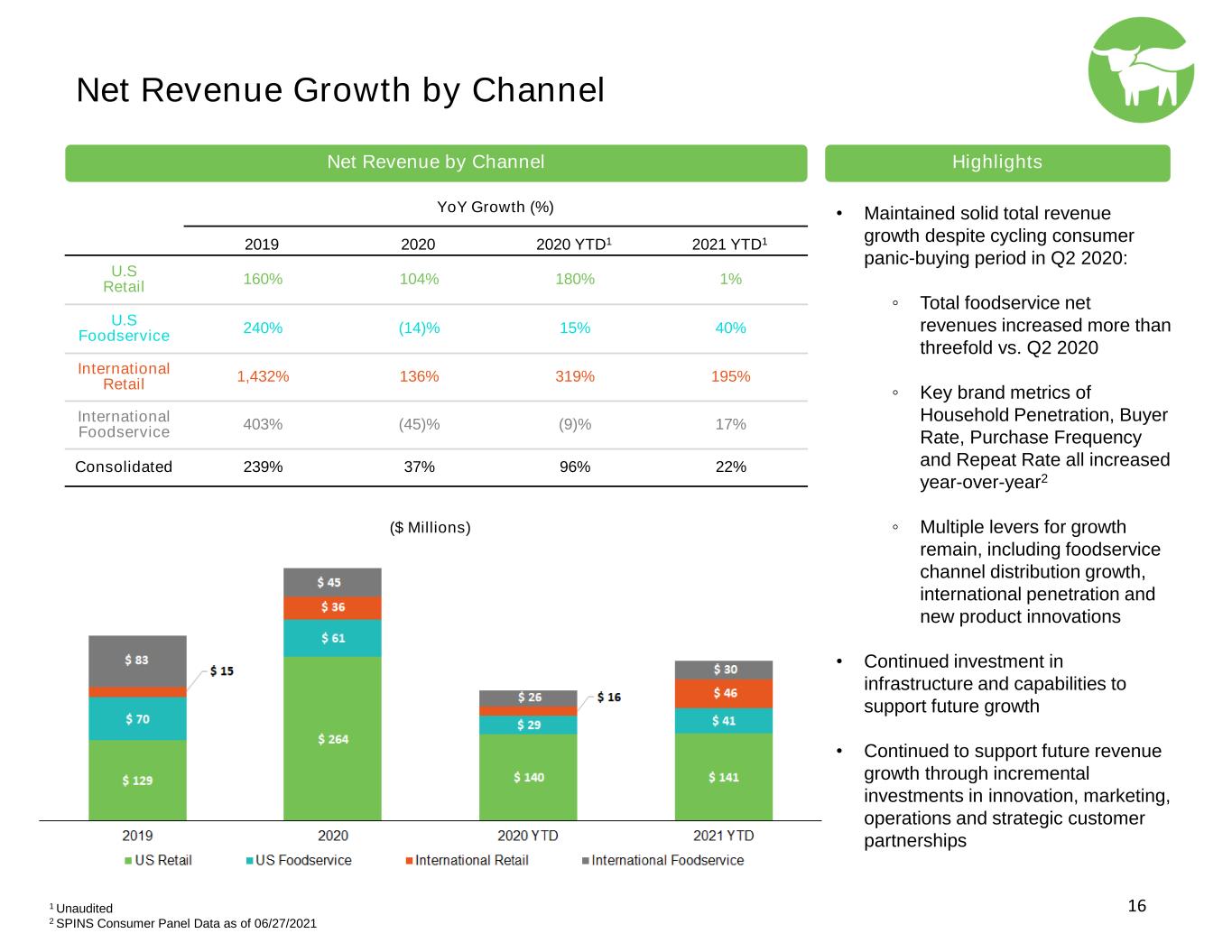
Net Revenue Growth by Channel 16 Net Revenue by Channel 1 Unaudited 2 SPINS Consumer Panel Data as of 06/27/2021 Highlights 2019 2020 2020 YTD1 2021 YTD1 U.S Retail 160% 104% 180% 1% U.S Foodservice 240% (14)% 15% 40% International Retail 1,432% 136% 319% 195% International Foodservice 403% (45)% (9)% 17% Consolidated 239% 37% 96% 22% YoY Growth (%) • Maintained solid total revenue growth despite cycling consumer panic-buying period in Q2 2020: ◦ Total foodservice net revenues increased more than threefold vs. Q2 2020 ◦ Key brand metrics of Household Penetration, Buyer Rate, Purchase Frequency and Repeat Rate all increased year-over-year2 ◦ Multiple levers for growth remain, including foodservice channel distribution growth, international penetration and new product innovations • Continued investment in infrastructure and capabilities to support future growth • Continued to support future revenue growth through incremental investments in innovation, marketing, operations and strategic customer partnerships ($ Millions)

1 See appendix for reconciliation of Adjusted EBITDA 2 Restructuring expenses are included in SG&A operating expenses Gross Margin and Operating Expense Update 17 • YoY gross margin increase primarily driven by non- recurrence of product repacking activities attributable to COVID-19 in the year-ago period and lower direct material costs per unit, partially offset by higher fixed overhead costs per unit, increased transportation costs, and higher depreciation and amortization expense. • Operating expenses were higher primarily due to growth in overall headcount levels to support the Company's international growth and operations and innovation capabilities, increased investments in marketing, increased production trial activities, higher restructuring expenses primarily reflecting increased legal expenses, and higher outbound freight costs included in the Company's selling expenses. Gross Profit and Margin HighlightsOpEx and OpEx % of Net Revenues ($ millions) Adjusted EBITDA1 ($ millions) $25.3 $11.8 $25.6 $(13.1) 36.9% 47.9% ($ millions) Gross Margin Operating Expenses2 as % of Net Revenues R&D as % of Net Revenues 5.8% 11.5% 33.5% 30.1% 33.9% 31.1%
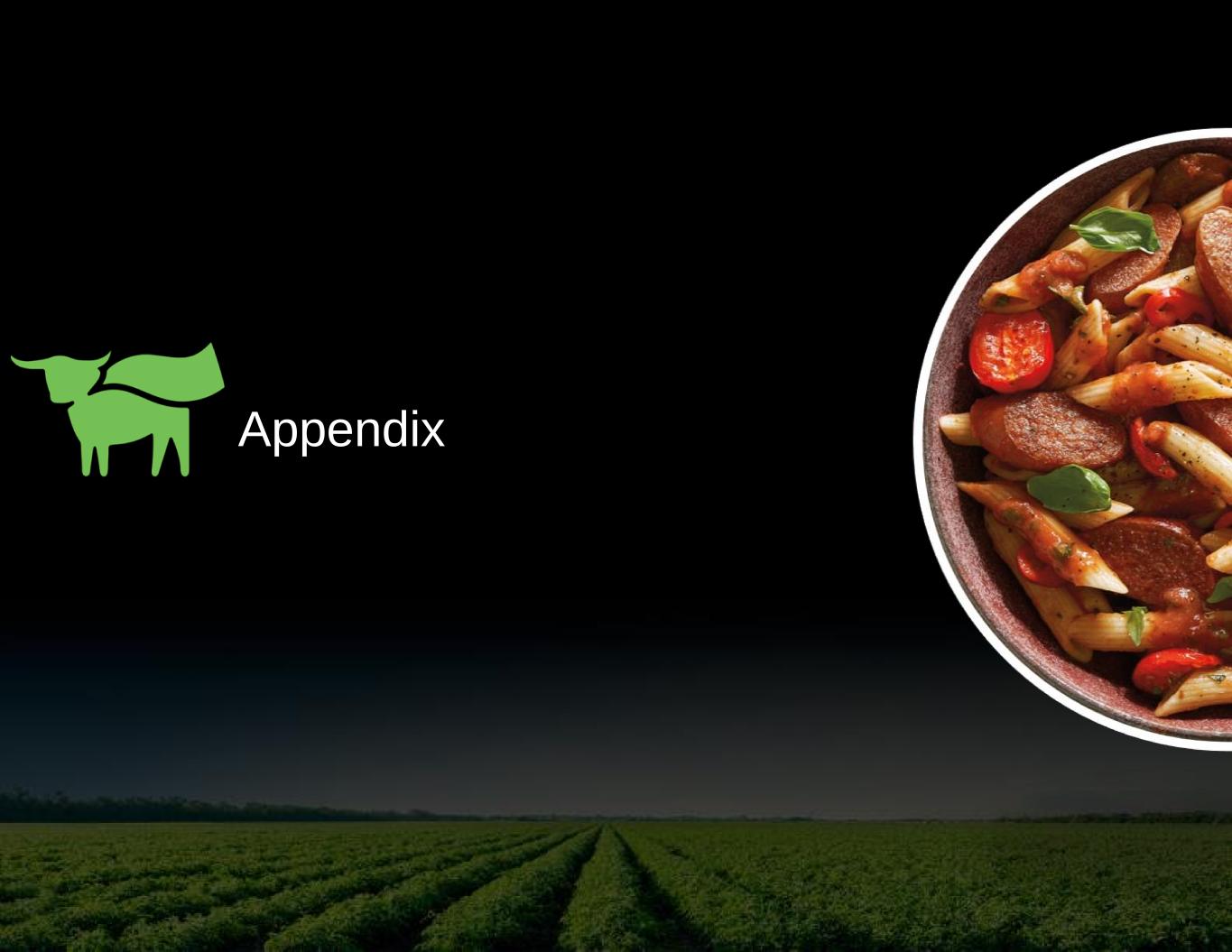
Appendix

Reconciliation of Non-GAAP Financial Measures Reconciliation of Adjusted gross profit, Adjusted gross margin and Adjusted net (loss) income (unaudited) 19
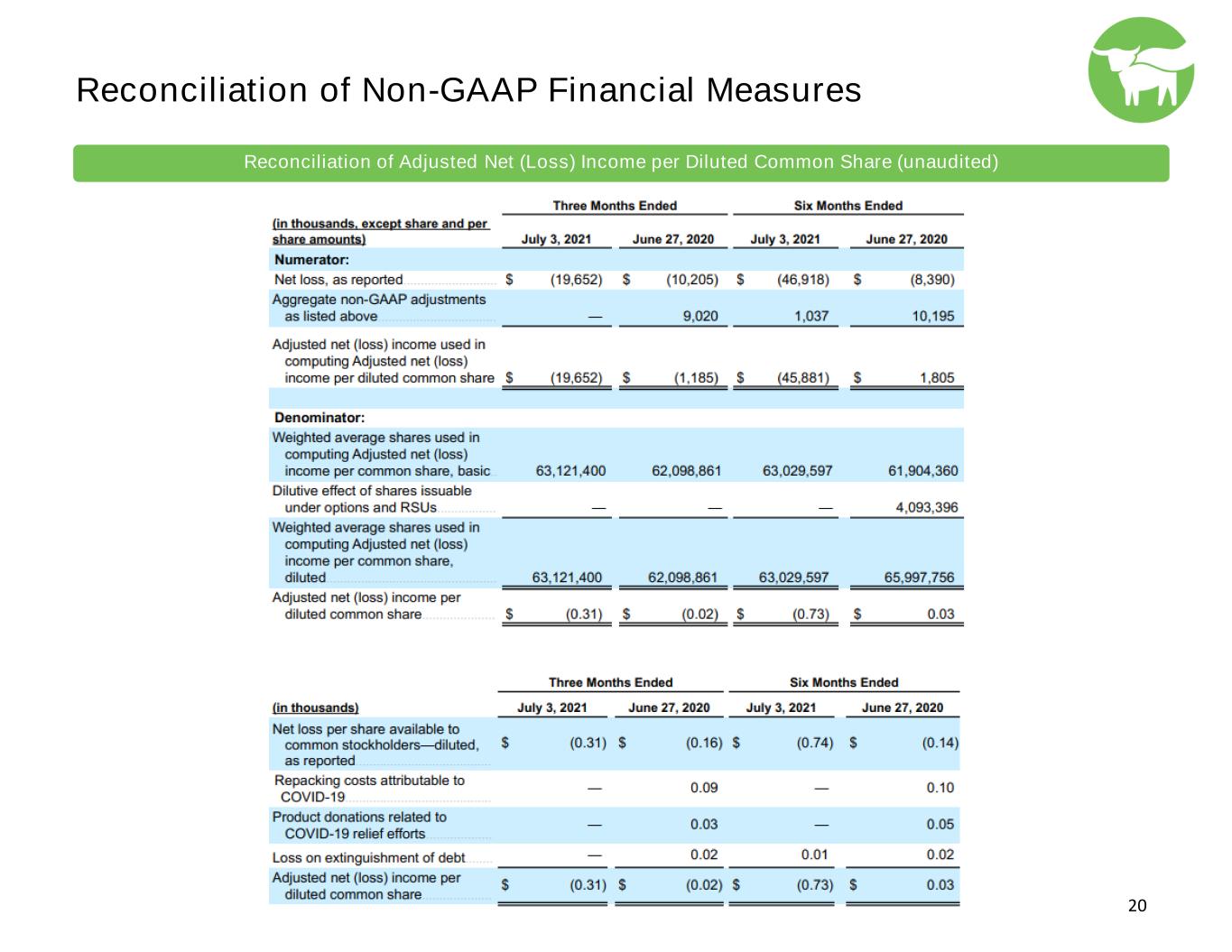
Reconciliation of Non-GAAP Financial Measures Reconciliation of Adjusted Net (Loss) Income per Diluted Common Share (unaudited) 20
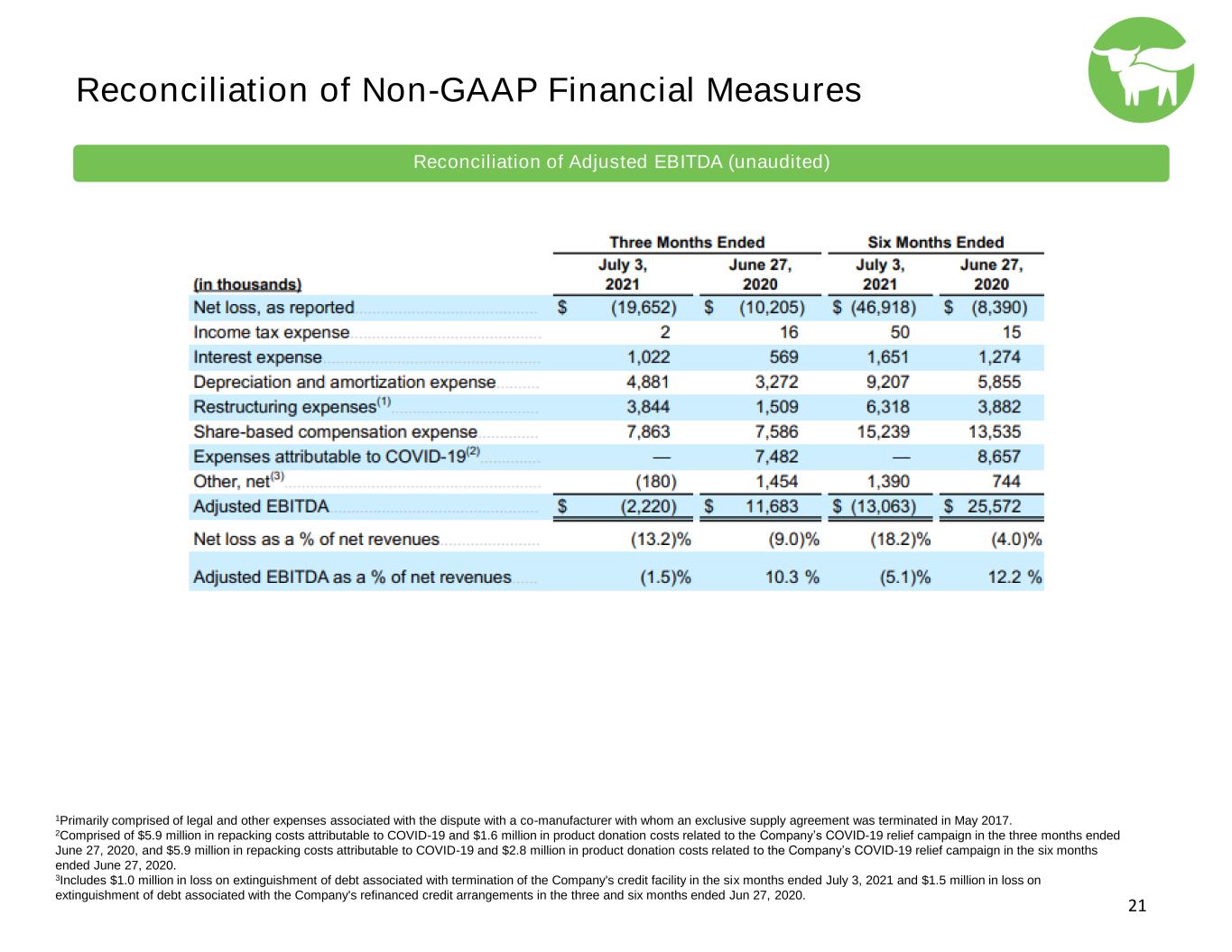
1Primarily comprised of legal and other expenses associated with the dispute with a co-manufacturer with whom an exclusive supply agreement was terminated in May 2017. 2Comprised of $5.9 million in repacking costs attributable to COVID-19 and $1.6 million in product donation costs related to the Company’s COVID-19 relief campaign in the three months ended June 27, 2020, and $5.9 million in repacking costs attributable to COVID-19 and $2.8 million in product donation costs related to the Company’s COVID-19 relief campaign in the six months ended June 27, 2020. 3Includes $1.0 million in loss on extinguishment of debt associated with termination of the Company's credit facility in the six months ended July 3, 2021 and $1.5 million in loss on extinguishment of debt associated with the Company's refinanced credit arrangements in the three and six months ended Jun 27, 2020. Reconciliation of Non-GAAP Financial Measures Reconciliation of Adjusted EBITDA (unaudited) 21





















